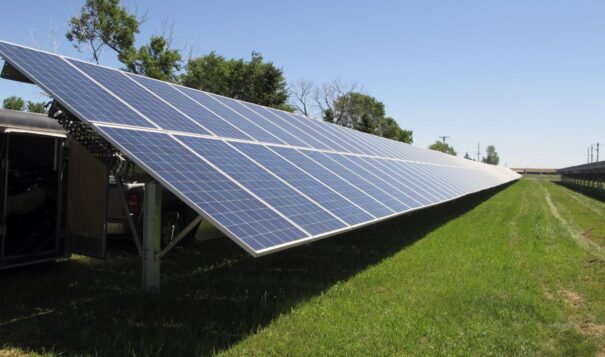News Based on facts, either observed and verified directly by the reporter, or reported and verified from knowledgeable sources.
Northern Plains tribes get $135 million for solar power
 An array of solar panels glisten in the sun outside Cannon Ball, N.D., located on the north side of the Standing Rock Indian Reservation, where the grand opening for the project was held on Friday, July 26, 2019. The project was motivated in part by the controversial Dakota Access pipeline that was built over the objections of Native American leaders and others. The solar project is meant as a first step toward clean energy independence and a way to power all 12 of the reservation communities. (AP Photo/Dave Kolpack)
An array of solar panels glisten in the sun outside Cannon Ball, N.D., located on the north side of the Standing Rock Indian Reservation, where the grand opening for the project was held on Friday, July 26, 2019. The project was motivated in part by the controversial Dakota Access pipeline that was built over the objections of Native American leaders and others. The solar project is meant as a first step toward clean energy independence and a way to power all 12 of the reservation communities. (AP Photo/Dave Kolpack)
New funding from the EPA could help tribes to revolutionize energy in rural lower-income communities
A coalition of 14 tribes across the Northern Great Plains has been awarded $135,580,000 by the Environmental Protection Agency for residential solar energy projects.
“Our future depends on changing our approach to energy. All forms of energy will play a role,” said Mark Fox, Chairman of the Mandan, Hidatsa, Arikara Nation in an April 22 press release. “We are honored to lead a coalition of 14 tribes in our region to develop the efficient, resilient, and renewable energy systems that the Solar for All program will support.”
A 2023 Report to Congress from the U.S. Department of Energy identified that many tribal communities typically pay a higher-than-average rate for electricity, use a higher-than-average portion of their income for energy costs, and have a higher-than-average amount of homes without electricity.
For rural Indigenous communities, this funding could promote energy independence, reduce energy costs and begin economic revitalization.
The Northern Plains Tribal Coalition is a partnership between Indigenized Energy, a Native-led nonprofit and a collective group of 14 tribes. The initiative was started specifically to help tribal nations to apply for the multi-million dollar Solar for All grant. Funding will help tribes shift from extractive energy sources such as fossil fuels to renewable energy systems.
The coalition consists of the Blackfeet Nation, Sisseton-Wahpeton Oyate, Mandan, Hidatsa and Arikara Nation, Menominee Indian Nation of Wisconsin, Turtle Mountain Band of Chippewa, Spirit Lake Nation, Rosebud Sioux Tribe, Yankton Sioux Tribe, Oglala Sioux Tribe, Flandreau Santee Sioux Tribe, Northern Cheyenne, Chippewa-Cree Rocky Boy, Fort Peck Sioux Tribes and Northern Arapahoe Tribe.
The Mandan, Hidatsa and Arikara Nation, which leads the coalition, will be the lead recipient of the funds. Solar for All funds will be divided depending on how many households each tribe has.
“Overall it’s going to look a little different for each tribe, each community has different needs and a different environment,” said Garrett Renville, chairman of the Sisseton-Wahpeton Oyate. “We’re looking to add solar energy to about 5,000 residential homes.”
The Sisseton-Wahpeton Oyate is specifically looking to use its funds to add solar panels to nursing homes and multigenerational family homes around the Lake Traverse Reservation in northeastern South Dakota.
“It’s pretty hard for one tribe to do this alone,” Renville said. “Most tribes don’t have the capacity or people in-house to apply. Most of the time we’ll have to go out and find somebody to help us develop something like this, fortunately, Cody Two Bears from Standing Rock and people from MHA put this coalition together. We just ended up with this bigger coalition.”
Indigenize Energy was created initially in response to the No-Dakota Access Pipeline movement and the fight against fossil fuels.
“I saw there was a need in our part of the country,” said founder Cody Two Bears, a citizen of the Standing Rock Sioux Tribe, during an April 22 press conference. “Renewable energy was pretty much non-existent in the midwest. … It was really important for me to bring some of these resources to our homelands.”
Two Bears used his knowledge of renewable energy to help craft a plan with the coalition, which
represents the first time in history tribes in the region have joined forces to work together for a clean energy future.
The Solar for All program is part of the resulting $27 billion Greenhouse Gas Reduction Fund This specific award is from the Biden-Harris administration’s Inflation Reduction Act and Greenhouse Gas Reduction Fund. In 2023, the EPA invited competitive proposals for the $7 billion fund, the largest investment in climate and energy in American History.
